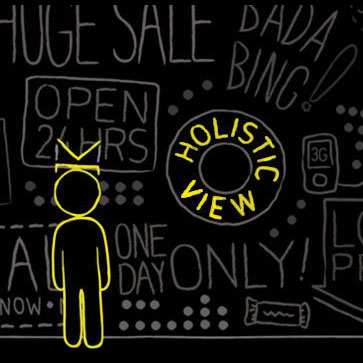Online Advertising: The Rise of Pops

By Patricia Rodriguez, Head of Public Relations, Qadabra
The rise of the internet gave advertising a medium to evolve in and allowed advertisers to reach their audiences like never before. The amount of format possibilities and their interactive qualities gave web banners a characteristic trait that has made them one of the ad industries favorite vehicles. One of those formats, pops, made its appearance in a huge way in the mid-90s and is still one of online advertising's favorite banners.
Advertising Dot Com
The 1990s were a memorable era for many reasons: the Gulf War, the first cloned sheep, South Africa's first African American president. But the 90s were also a time of decisive change in the way information was shared. The 1990s was the era where "www" became more than just three letters; they became an incomparable platform for information exchange that would transform global communication forever.
Online advertising made its big debut in 1994, when Web browsers gave way for more sophisticated websites.
Since then, the Internet has become one of, if not THE main vehicle for advertising; and how could it not? It's much more affordable, has global reach, immediate impact, detailed outcome measurability, mobility across platforms, audience segmentation possibilities, and so on to a very long list of advantages that are hard to ignore as an advertiser.
This being said, the world's biggest companies started promote themselves through banner campaigns across websites worldwide. Obviously, formats started to evolve.
The Pop Up Revolution
In the mid-90s, Netscape came up with JavaScript programming language and introduced a new command that enabled surfers to open a new browser window. Advertisers saw the huge potential that lay herein and by early 1997, the pop-up window made its way into the online advertising world.
What are pop ups and pop unders?
As the name simply states, a pop up is a new browser window that displays an advertisement in front of the user's current webpage. Similarly, a pop under is a new browser window that appears under the user's active window.
These types of rich media ads have many advantages in comparison to regular banners. For one, they're exactly that: rich media. For starters, pops cannot be ignored, because they appear immediately on screen, are interactive, have high user engagement and are usually very clear call-to-action advertisements. Undoubtedly, pops have a great advantage over standard banners, as advertisers are more than aware. At the risk of sometimes being a bit invasive for Web surfers, pops usually generate very high conversion results due to their engaging qualities (attractive design, flash media, music, video, etc.)
How do you implement them?
Implementing pops is as easy as with standard banners. Once the ad tag is generated in an ad network system, it simply needs to be copied and pasted within the website's code.
The only difference is that pop up/under ad tags are implemented within the site code "head". The implementation process should look like this:
Insert the ad code
When implementing standard ads, the tag must be inserted within the body of the site, not the head.
Who should use them?
Pop up/unders are not for everyone. Certainly, there are many site owners that have opted against them due to their invasive qualities. And these are usually publishers that look for contextual advertising that can integrate harmoniously with their site's content and design.
On the other hand, there are thousands of webmasters that are focused on performance as their main priority. These are the publishers that should use Pops, because although these banners can indeed be a bit on the aggressive side, they have been statistically proven to generate higher results simply because advertising works best when a user feels engaged with what he is seeing. It's all a matter of impact and involvement with what the advertiser is trying to sell, and pops are the perfect way to grab users' attention and get them involved.
Best Practices
Overcrowding: The most common mistake with pop ups is to overcrowd. Many publishers see results going up and immediately want to add more banners to the mix, thinking this will double the profits. In fact, this can be quite counterproductive; a site overcrowded with pop ups can wear out its visitors and dangerously increase a website's bounce rate to the point of "no return".
Probably the best way to maximize a pops' performance is by placing no more than one per webpage, and no more than 4-5 altogether throughout the website.
Frequency Caps: Pop ups and pop unders should be set at a frequency cap no higher than 2/24 to not exhaust the website's visitors.
Why and how do they boost revenue?
Performance Measurability: There is no better way to improve results than to measure them. Analyzing statistics is the safest way to make sure you're not investing in the blind. This is one of the greatest advantages offered by rich media ads like pops. Pops offer much more in-depth analytics than regular banners; it is possible to quantify visitors' behaviors, audience segments, and almost any detail related to a specific visitor's interaction with the ad.
User involvement and interaction: Pops DEMAND attention. Whether it's the attractive visuals, intricate design, straightforward call-to-action, or "in your face" approach, Pops are eye-catching enough to at least get a user interested and look twice. In advertising, this is often all that it takes for an advertisement to meet its goal; regardless of whether its branding, collecting information, direct sales, or promoting a cause, the ultimate goal is to "get to the people". Pops' interactive characteristics simply make it that much easier.
CTRs: When it comes to online advertising, a publisher's success lies in knowing the tricks of the trade. Having knowledge of the best ad formats, tools, and knowing how to analyze general stats is the only way to move forward in such a competitive world as is the online advertising one. It is therefore very important to look for the right ad platforms; platforms that offer several solutions of pop ups and pop unders, platforms that count with experienced professionals and a reliable support system.
Further information on this topic and in-depth details on optimizing pops performance can be found at Qadabra.com.









